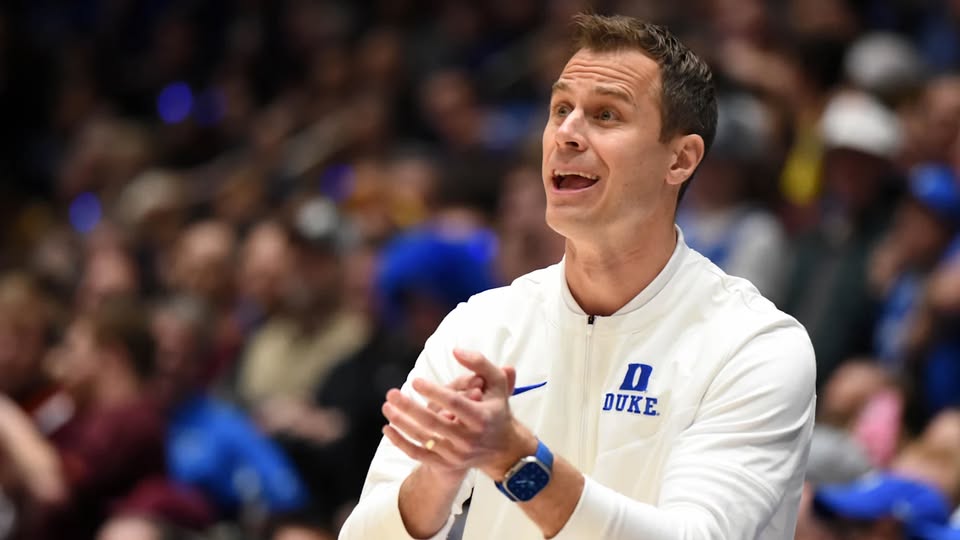Duke enters its first fully Scheyer‑constructed recruiting cycle under the shadow of big expectations. With a national championship window looming and an ACC loaded with competition, Jon Scheyer’s staff has zeroed in on a collection of elite 2026 prospects — a half‑dozen standout names, plus a few strategic wildcard targets. Each brings a distinct element Duke covets: size, athleticism, guard play, shooting, and versatility. Let’s dive into Scheyer’s blueprint for dominance, detailing the key recruits he’s courting and what each could bring to Durham.
First on the radar is Jordan Smith Jr., a five‑star guard from Paul VI Catholic in Virginia, established early as Duke’s first official 2026 offer . Smith, a 6‑3 combo guard, ranks eighth nationally and embodies the archetype Scheyer has long preferred: high IQ, defensive tenacity, and scoring flair. Duke’s pursuit includes an in‑school visit, underscoring how seriously they view him With Paul VI already a cottage industry for Duke talent (Roach, Keels, Harris, Ngongba), Smith represents continuity — a proven product of the pipeline. His fit? Instant, on both ends.
In close pursuit is Brandon McCoy Jr., the consensus No. 1 point guard in 2026. A 6‑4 floor general from St. John Bosco (CA), McCoy boasts elite vision, size, and scoring ability. Duke has extended an offer and remains active; rumors swirl of a potential tandem with fellow St. John Bosco wing Christian Collins ( McCoy is a North‑South connector who can orchestrate beneath the rim, while Collins adds 6‑8 length, athleticism, and two‑way versatility. Duke’s staff meeting Collins during a West Coast swing and offering him late in the process speaks to their targeted precision With these two, Scheyer addresses both primary ball handling and frontcourt mobility — pillars in his fast‑paced, switch‑heavy scheme.
That frontcourt blueprint extends west to Miikka Muurinen, a 6‑10 big man from Compass Prep (AZ), now sitting in the top six nationally. Duke offered him in July and scheduled a late‑September official visit . Muurinen combines size, rim‑running athleticism, and a fluid offensive skill set, making him a modern Duke big. His visit, timed alongside stops at Michigan and Arkansas, positions Duke squarely in his recruitment derby.
Supporting the frontcourt depth is Sebastian Wilkins, a 6‑8 forward from Brewster Academy in New Hampshire, ranked No. 28 overall and No. 7 at his position . Duke extended an offer around April 2025, and Wilkins has since committed — proof Duke isn’t just chasing consensus five‑stars, but also high-upside four‑stars His presence would reinforce the forward rotation, blending untapped potential with proven pedigree.
Possibly the most intriguing dark‑horse is Kohl Rosario, a 6‑5 guard from Moravian Prep, North Carolina. Rated as a three or four star, recent evaluations project a steep climb in his rankings Rosario boasts a freakish 42‑inch vertical, physical maturity, and a pro‑ceiling flair. Just as Scheyer unearthed hidden gems like Kon Knueppel, Rosario could blossom in Durham. Duke already offered and UConn, UNC, and Kansas have entered the equation. If Rosario’s star continues to rise, he becomes a high‑reward pick in a scholarship allocation that values potential.
Further enriching the wishlist: Jason Crowe Jr., a 6‑2 guard with top‑five-grade upside who publicly called Duke his childhood dream school . Scheyer has taken note, and Crowe fits the mold: fiery, creative, and capable of impacting immediately. Duke’s interest here underscores their relentless guard focus.
Still in the mix is Caleb Gaskins, a 6‑8 power forward and five‑star at Montverde Academy who recently picked up Duke interest . Gaskins has the elite athletic frame and championship experience that Duke loves — think RJ Barrett, Cooper Flagg. Scheyer’s contact confirms Montverde remains a strategic footprint.
Rounding out chatter-worthy names is rising pure shooter Nate Ament, the 6‑10 Ohio sharpshooter in Duke’s top‑five final five list for 2025; he’s spoken openly about Duke and remains close with incoming wing Shelton Henderson Though Ament will commit in April 2025, his involvement signals Duke’s appreciation for floor spacing — a premium in modern ACC play.
– Elite backcourt balance: Smith and McCoy deliver established floor-thumpers at guard, with Crowe and Rosario adding creativity and mix-in value. This backcourt may remake Duke’s perimeter identity — combining scoring, defense, playmaking, and length.
– Versatile frontcourt rotation: Collins, Muurinen, Wilkins, and Gaskins each deliver a different mix of size, athleticism, rim play, and perimeter touch. This generates matchup flexibility, switching ability, and depth from power forward through center — the type of depth Duke needs in dark ACC trenches and deep NCAA runs.
– Up‑and‑comers & pipelines: By pursuing Rosario and Crowe (who may ascend into higher tiers) and tapping Paul VI and Montverde pipelines, Scheme balances safety with upside. It’s a hedged portfolio that adds incremental lottery upside or reliable role talent.
This cycle, Scheyer leans heavily on developmental upside, risking late breakout reversals. For example, Rosario and Gaskins aren’t household names yet — if they stall, Duke could be left without established stars. Conversely, chasing consensus five-stars like McCoy, Smith, and Collins strengthens Duke’s national presence, even if some wildcards flop.
His pipeline bets in elite high schools raise expectations — but also enhance culture, continuity, and fit. Paul VI, Montverde, St. John Bosco — those programs breed Duke-ready players in staff-familiar molds.
Let’s take each name and project the potential fit:
Jordan Smith Jr. arrives as a two-way disruptor. Scheyer teams have valued his defensive intensity — an engine that lifts perimeter rotations and energizes Cameron Indoor. Offensively, he’s dynamic — capable of slash scoring and scoring off craft. Smith can graduate from instant contributor to ACC standout, and Duke is banking on his steady climb.
Brandon McCoy Jr. changes the mold — a big‑guard at 6‑4 capable of leading the offense, initiating in transition, and creating mismatches. He provides floor‑spacer shooting, rim finishing, and can defend multiple positions. McCoy could become the next evolution of a Duke point guard — bigger, more versatile.
Christian Collins matches that with thin-timeline versatility. At 6‑8, he can switch onto wings, rebound, run the floor, and pop threes. His follow‑up after McCoy creates tight positional synergy — two guards sized 6‑4+ but with distinct roles.
Miikka Muurinen anchors frontcourt aspirations with length and upside — rim protection, mobility, offensive fluidity. Think of him as engineering a new line of blueblood bigs.
Sebastian Wilkins settles for blue-chip forward depth. As a high-level four-star, he carries starter-level upside, complementary to bigger recruits. His commitment signals Duke’s aggressive roster management.
Kohl Rosario embodies upside risk/reward. If he blossoms into a top-five guard by 2026, Duke added a steal. If not, they’re left with placeholder depth. But schematically, Rosairo fits Scheyer’s disruptive guard profile — length, athleticism, play‑creation.
Jason Crowe Jr. and Caleb Gaskins fill additional layers: Crowe brings intensity, shot-making guard flavor and local pipeline connection. Gaskins, though under the radar, brings Montverde pedigree and big team championship experience — not to mention upside in his father-sized frame.
Nate Ament exemplifies Duke’s commitment to shooting. A 6‑10 pure perimeter guy in the back end of the wishlist, he fits with the spacing theme that Scheyer’s style increasingly demands
Scheyer isn’t just chasing rankings. He’s choosing players who fit Duke’s identity: rim protection, length, versatility, defensive commitment, and spacing. He’s capitalizing on long-standing prep pipelines like Paul VI and Montverde but also proactively chasing West Coast talent like McCoy and Collins, where rival bluebloods await.
The staff has also shifted concentration. Only one target — Wilkins — is a four-star so far. The rest are consensus five-stars or rapidly-rising players. Scheyer clearly wants to reload, not just replenish.
Interestingly, Scheyer’s approach mirrors his last successful cycle: balance veterans with high-upside youth, and build around scheme fit rather than pure profile.
It’s a hyper‑competitive field. Builders like Kentucky, Duke’s ACC rival UNC, Kansas, Michigan, Arizona, among others, are in on Smith, McCoy, Muurinen, Collins. Duke previously lost some long-shot 2025 targets in part because of understated attention to one-and-done talent that flirted with transferring or high-profile packages. But this year, Scheyer is placing his bets earlier and doubling down on in-house development — even as portal options abound
If Duke lands McCoy, Smith, Collins, Muurinen, and Wilkins, they’ll boast a five‑star‑heavy nucleus, balanced guard-big synergy, and ACC dominance potential. Add breakout guards like Rosario or Crowe and it’s national title contention territory.
Failure to close on two or more top targets doesn’t doom the class — depth and culture remain without heavy star power. Still, the blueprint is clear: target elite perimeter play, size and switchability, plus layers of shooter depth.
In many ways, this is the ultimate Scheyer class: built for versatility, long-term upside, cultural fit, and ACC/American style dominance. It’s not flashy — it’s purposeful. By aligning roster architecture with Scheyer’s on-court philosophy, Duke aims to future-proof its success.
As we continue tracking commitments through next April, every offer holds weight. This 2026 crop will define whether Duke cements its post‑Coach K architecture — a program built less on singular superstars and more on system-savvy star collaborations.
Bottom line: Duke’s 2026 wishlist isn’t just a wishlist — it’s a calculated roster-building manifesto. With these six-plus prospects, Scheyer’s craft comes into full view. Immediate defense, elite ball handling, frontcourt versatility, spacing, and moldable upside: if all stars align, Duke will enter the next decade as the template of the modern college basketball powerhouse.



